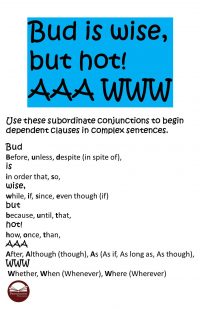Teaching Essay Style: 15 Tricks of the Trade
“Never start a sentence with But.” Countless middle school and high school English-language arts teachers cringe when their students faithfully repeat this elementary school dictum. “Never use I in your five-paragraph essay.” Now university professors similarly cringe and shake their heads at the straight-jacketed rules placed upon their students. However, maybe there is a method to our madness. Perhaps these writing absolutes serve a useful purpose for coaching developing writers. Perhaps the little white lies that we teach our students are actually our tricks of the trade.
Instead of bemoaning past “bad writing instruction,” we should celebrate the fact that our students did remember these rules. After all, writing teachers of all levels are always shocked at how little transfer students make from grade to grade or from course to course. Anything that students retain from previous writing instruction can be used by resourceful teachers as “teachable moments.” Perhaps it’s time that we trust our colleagues that they understand best what works for their students at their age levels.
Teaching all of the seemingly arbitrary rules and enforcing them in student writing practice makes sense. As writers mature, 7-12 English-language arts teachers and university professors can encourage “rule breaking” with sly nods and winks. Without knowing the rules, developing writers cannot make informed choices about which ones to break and when they should break them to serve their writing purposes. In fact, the best writers are rule-breakers. E.B. White revised and updated Strunk’s Bible of writing style, yet he consistently chose to break the rules in his own writing. He knew enough to consciously deviate from the norm.
Writing teachers should worry more when their students unconsciously deviate from the norm. Of course, other forms of prose and poetry have their own stylistic rules to learn and break. But this article will concentrate on those of the essay. So, following is a list of the Teaching Essay Style: 15 Tricks of the Trade.
- Require students to write in a formal voice. No figures of speech, slang, clichés, abbreviations, flowery language, or contractions. Teach them to dress in a tuxedo or bridesmaid dress when they are in a wedding, not baggy pants or skinny jeans with flip-flops.
- Teach students to write in third person. It’s not that the I is inappropriate in all essays. The problem is that the use of the I requires a sophisticated rationale and limited usage. For example, qualitative research requires the I; however, quantitative research does not. Let the post-graduate supervising professors teach their students to break this rule. Furthermore, the “no I rule” forces a certain degree of objectivity and requires students to focus on the subject, rather than on the writer. These are the real concerns of K-12 and university professors.
- Teach students not to use their to reference singular non-gender nouns. Approving such sentences as “The student likes their classes” transfers to other more egregious pronoun reference problems as in “Those desk in the back of our room belong to them guy.” Also, no one likes reading he/she, him or her, s/he or the like. It does make sense to teach students to pluralize when at all possible, but the use of he or she throughout (please don’t alternate!) is no crime.
- Teach students to vary their sentence structures. “Never more than two simple sentences back-to-back and never follow a complex sentence with another complex sentence” will increase readability. “Have no more than 50% of your sentences follow the subject-verb-complement pattern” helps students focus on sentence variety.”
- “No more than one to-be verb per paragraph” will force students to avoid passive voice and strengthen nouns and verbs.
- Require your students to write in complete sentences. “No declarative sentences beginning with but, and, or, so, like, because, how, when, where, or why, unless you finish them” reduces fragments.
- “No unparallel verb structures” helps eliminate verb tense errors and awkward writing. For example, “Going to the store, to get some gas, and maybe have a cup of coffee are appearing on my agenda for today” can be eliminated with this rule.
- Require transitions between paragraphs. Sophisticated writers may have no need, but your students do to write coherent essays.
- Teach your students to choose simple words, not their weekly vocabulary words. Precision is better than pomposity.
- Demand specificity and do not permit generalizations, except in conclusions.
- Don’t allow your students to make parenthetical remarks. Most misuse these.
- Never allow repetition for emphasis. Developing writers do not have the skills to use this rhetorical strategy properly.
- Never allow double negatives. Students will confuse their readers.
- Teach students not to over-state evidence and to limit their conclusions.
- Teach students to place pronoun references close to their subjects to avoid ambiguity and dangling modifiers.
*****

TEACHING ESSAYS BUNDLE
The author’s TEACHING ESSAYS BUNDLE includes the three printable and digital resources students need to master the CCSS W.1 argumentative and W.2 informational/explanatory essays. Each no-prep resource allows students to work at their own paces via mastery learning. How to Teach Essays includes 42 skill-based essay strategy worksheets (fillable PDFs and 62 Google slides), beginning with simple 3-word paragraphs and proceeding step-by-step to complex multi-paragraph essays. One skill builds upon another. The Essay Skills Worksheets include 97 worksheets (printables and 97 Google slides) to help teachers differentiate writing instruction with both remedial and advanced writing skills. The Eight Writing Process Essays (printables and 170 Google slides) each feature an on-demand diagnostic essay assessment, writing prompt with connected reading, brainstorming, graphic organizer, response, revision, and editing activities. Plus, each essay includes a detailed analytical (not holistic) rubric for assessment-based learning.




